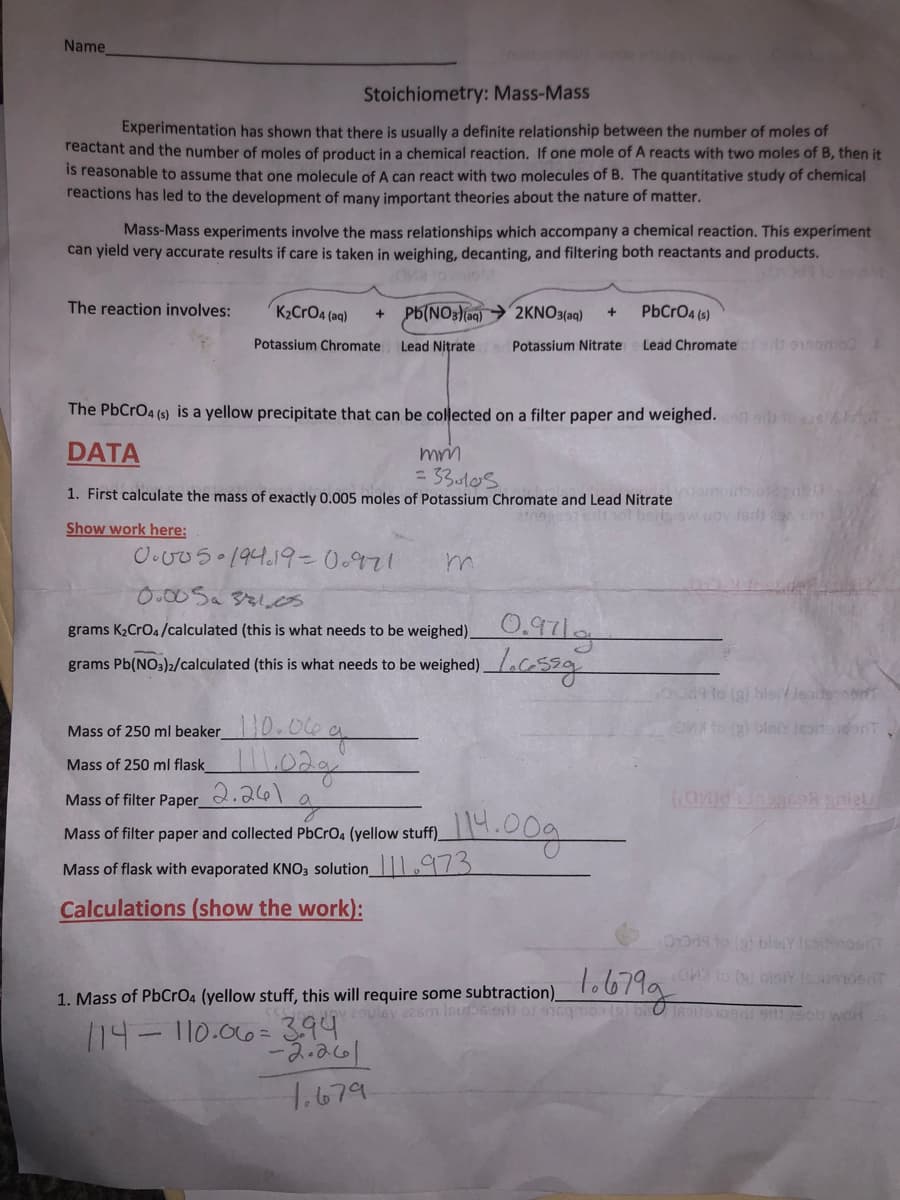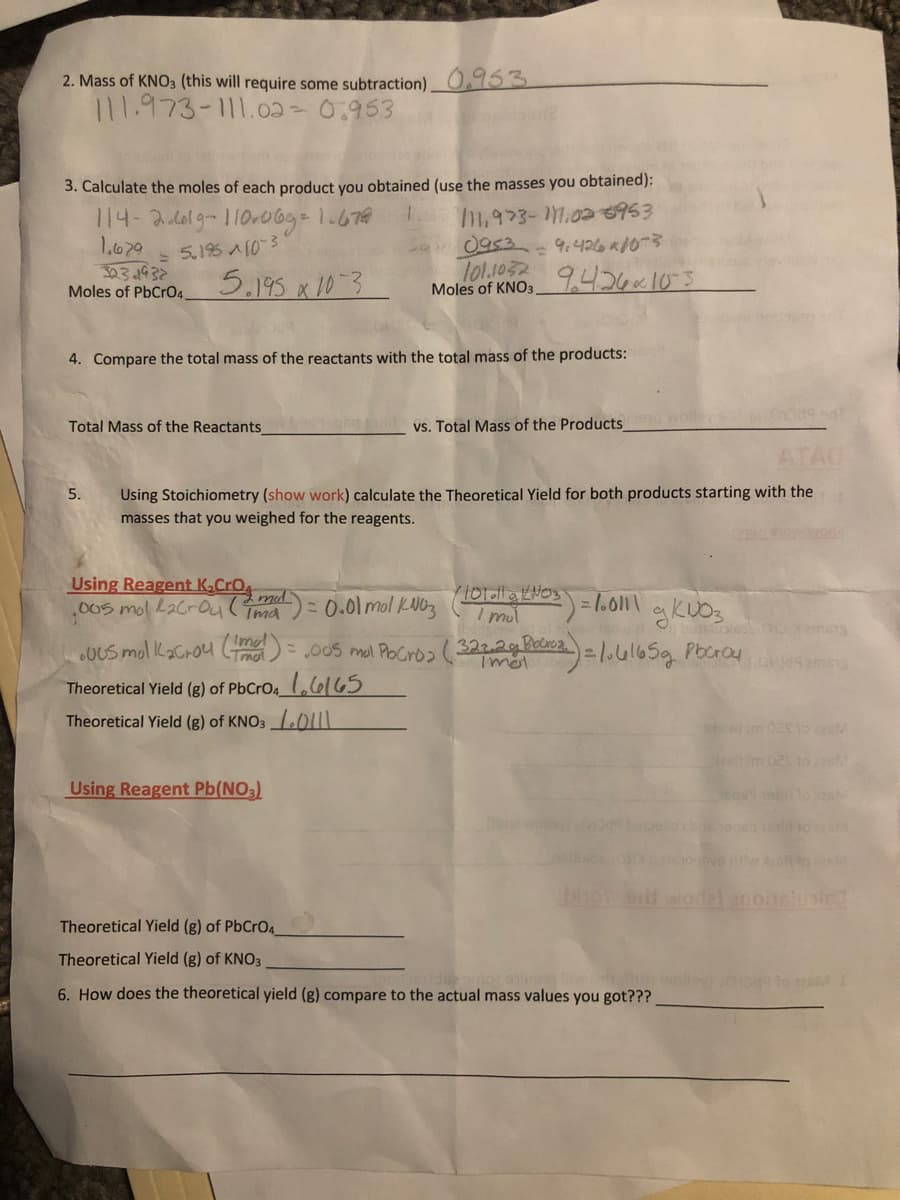4. Compare the total mass of the reactants with the total mass of the products: Total Mass of the Reactants vs. Total Mass of the Products ATAC
4. Compare the total mass of the reactants with the total mass of the products: Total Mass of the Reactants vs. Total Mass of the Products ATAC
Chemistry: The Molecular Science
5th Edition
ISBN:9781285199047
Author:John W. Moore, Conrad L. Stanitski
Publisher:John W. Moore, Conrad L. Stanitski
Chapter3: Chemical Reactions
Section: Chapter Questions
Problem 141QRT
Related questions
Question
I need help with number 4! Thank you so much!!!

Transcribed Image Text:Name
Stoichiometry: Mass-Mass
Experimentation has shown that there is usually a definite relationship between the number of moles of
reactant and the number of moles of product in a chemical reaction. If one mole of A reacts with two moles of B, then it
is reasonable to assume that one molecule of A can react with two molecules of B. The quantitative study of chemical
reactions has led to the development of many important theories about the nature of matter.
Mass-Mass experiments involve the mass relationships which accompany a chemical reaction. This experiment
can yield very accurate results if care is taken in weighing, decanting, and filtering both reactants and products.
The reaction involves:
K2CrO4 (aq)
PB(NO3 (aq) > 2KNO3(aq)
PbCrO4 (s)
Potassium Chromate
Lead Nitrate
Potassium Nitrate
Lead Chromatefst 91samo
The PbCrO4 (s) is a yellow precipitate that can be collected on a filter paper and weighed.
DATA
= 33ul0s
1. First calculate the mass of exactly 0.005 moles of Potassium Chromate and Lead Nitrate
not bads ow
fedh 29 c
Show work here:
O.v05 194.19-0.971
0.00Sa 321.cs
grams K,CrOa/calculated (this is what needs to be weighed)O,97|a
grams Pb(NO3)>/calculated (this is what needs to be weighed)aG539
Mass of 250 ml beaker0.06 g
Mass of 250 ml flask 02g
Mass of filter Paper_
Mass of filter paper and collected PbCrO4 (yellow stuff)_
Mass of flask with evaporated KNO3 solution 973
Calculations (show the work):
L.679g
1. Mass of PbCrO4 (yellow stuff, this will require some subtraction)o o71g
/14– 110.006=3.94
1,679

Transcribed Image Text:2. Mass of KNO3 (this will require some subtraction) 0.953
111.973-111.02- 0:953
3. Calculate the moles of each product you obtained (use the masses you obtained):
114-261g-110.0bg=1.679
1.679
303.1932
Moles of PbCrO4
5.195 A103
0953
- 9.426 ad0
5.195 x 10-3
lo1.1032
Moles of KNO3
9.426~10-3
4. Compare the total mass of the reactants with the total mass of the products:
Total Mass of the Reactants
vs. Total Mass of the Products
Using Stoichiometry (show work) calculate the Theoretical Yield for both products starting with the
masses that you weighed for the reagents.
5.
Using Reagent K,CrO
.005mol L2CrOul Tma
0.01 mol kWbz (eT
Imut
00S mol PoCrb>( 3222g Boro2.
L,6165
.0US mol kaCrou Lmal
Theoretical Yield (g) of PbCrO4_
Theoretical Yield (g) of KNO3 011
Using Reagent Pb(NO3)
wol
enohslusie
Theoretical Yield (g) of PbCrO4
Theoretical Yield (g) of KNO3
6. How does the theoretical yield (g) compare to the actual mass values you got???
Expert Solution
This question has been solved!
Explore an expertly crafted, step-by-step solution for a thorough understanding of key concepts.
This is a popular solution!
Trending now
This is a popular solution!
Step by step
Solved in 2 steps

Knowledge Booster
Learn more about
Need a deep-dive on the concept behind this application? Look no further. Learn more about this topic, chemistry and related others by exploring similar questions and additional content below.Recommended textbooks for you

Chemistry: The Molecular Science
Chemistry
ISBN:
9781285199047
Author:
John W. Moore, Conrad L. Stanitski
Publisher:
Cengage Learning

Introductory Chemistry: A Foundation
Chemistry
ISBN:
9781337399425
Author:
Steven S. Zumdahl, Donald J. DeCoste
Publisher:
Cengage Learning

Chemistry for Engineering Students
Chemistry
ISBN:
9781285199023
Author:
Lawrence S. Brown, Tom Holme
Publisher:
Cengage Learning

Chemistry: The Molecular Science
Chemistry
ISBN:
9781285199047
Author:
John W. Moore, Conrad L. Stanitski
Publisher:
Cengage Learning

Introductory Chemistry: A Foundation
Chemistry
ISBN:
9781337399425
Author:
Steven S. Zumdahl, Donald J. DeCoste
Publisher:
Cengage Learning

Chemistry for Engineering Students
Chemistry
ISBN:
9781285199023
Author:
Lawrence S. Brown, Tom Holme
Publisher:
Cengage Learning

World of Chemistry, 3rd edition
Chemistry
ISBN:
9781133109655
Author:
Steven S. Zumdahl, Susan L. Zumdahl, Donald J. DeCoste
Publisher:
Brooks / Cole / Cengage Learning

Living By Chemistry: First Edition Textbook
Chemistry
ISBN:
9781559539418
Author:
Angelica Stacy
Publisher:
MAC HIGHER

Chemistry
Chemistry
ISBN:
9781305957404
Author:
Steven S. Zumdahl, Susan A. Zumdahl, Donald J. DeCoste
Publisher:
Cengage Learning